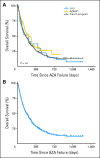Outcome of high-risk myelodysplastic syndrome after azacitidine treatment failure
- PMID: 21788559
- PMCID: PMC4859209
- DOI: 10.1200/JCO.2011.35.8135
Outcome of high-risk myelodysplastic syndrome after azacitidine treatment failure
Abstract
Purpose: Azacitidine (AZA) is the current standard of care for high-risk (ie, International Prognostic Scoring System high or intermediate 2) myelodysplastic syndrome (MDS), but most patients will experience primary or secondary treatment failure. The outcome of these patients has not yet been described.
Patients and methods: Overall, 435 patients with high-risk MDS and former refractory anemia with excess blasts in transformation (RAEB-T) were evaluated for outcome after AZA failure. The cohort of patients included four data sets (ie, AZA001, J9950, and J0443 trials and the French compassionate use program).
Results: The median follow-up after AZA failure was 15 months. The median overall survival was 5.6 months, and the 2-year survival probability was 15%. Increasing age, male sex, high-risk cytogenetics, higher bone marrow blast count, and the absence of prior hematologic response to AZA were associated with significantly worse survival in multivariate analysis. Data on treatment administered after AZA failure were available for 270 patients. Allogeneic stem-cell transplantation and investigational agents were associated with a better outcome when compared with conventional clinical care.
Conclusion: Outcome after AZA failure is poor. Our results should serve as a basis for designing second-line clinical trials in this population.
Conflict of interest statement
Authors' disclosures of potential conflicts of interest and author contributions are found at the end of this article.
Figures


References
-
- Nimer SD. Myelodysplastic syndromes. Blood. 2008;111:4841–4851. - PubMed
-
- Stone RM. How I treat patient with myelodysplastic syndroms. Blood. 2009;113:6296–6303. - PubMed
-
- Weber M, Hellmann I, Stadler MB, et al. Distribution, silencing potential and evolutionary impact of promoter DNA methylation in the human genome. Nat Genet. 2007;39:457–466. - PubMed
-
- Reik W, Dean W, Walter J. Epigenetic reprogramming in mammalian development. Science. 2001;293:1089–1093. - PubMed
Publication types
MeSH terms
Substances
Grants and funding
LinkOut - more resources
Full Text Sources
Other Literature Sources
Medical
Research Materials
Miscellaneous

